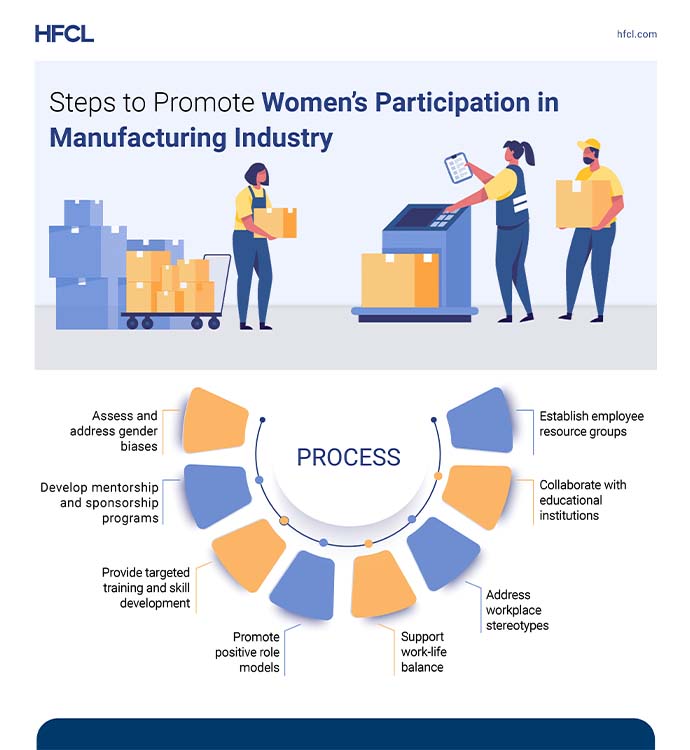From being a USD 2 trillion economy in 2014, India’s GDP has reached over USD 3.5 trillion, and the country has emerged as 5th largest economy in the world. Despite global challenges, the Indian economy has demonstrated resilience, as affirmed by the World Bank, which recognizes India as the fastest-growing economy among the largest emerging and developing markets. It is projected to achieve a growth rate of 6.3% for FY24.
The manufacturing sector holds substantial significance within the Indian economy, contributing approximately 15% to the nation's GDP and employing a vast workforce of over 62.4 million individuals. However, according to the India Economic Survey 2021-22, representation of women in the manufacturing sector remains relatively low, with only around 26% of the total workforce, approximately 16 crore women, engaged in this sector.
As India progresses towards being self-reliant, ‘Atmanirbhar Bharat’, and towards the path of modernization, the manufacturing industry will play a vital role in its growth and development. Recognizing the need for sustained growth and innovation, it is increasingly evident that a diverse workforce, including women, is essential. Gender diversity is important for fostering creativity, innovation, and improved decision-making by bringing together diverse perspectives and experiences. It promotes fairness, equality, and better performance in all aspects of society.
With the shift towards technology-driven processes, the emphasis is placed on skills such as problem-solving, critical thinking, and technical expertise, creating a level playing field that allows women to excel based on their abilities, thereby promoting gender diversity in traditionally male-dominated industries.

Role of Women in the Manufacturing Sector: Significance and Impact
On this note, below are a few reasons highlighting the importance of increasing women's representation in the manufacturing sector and how it can bring a new perspective to drive progress and prosperity.
Enhanced Creativity and Innovation
The manufacturing industry will gain from a larger range of viewpoints and experiences if gender diversity is increased. Women frequently contribute original methods to tackling problems and different perspectives, which may encourage innovation and creativity inside organizations. Diverse teams are more likely to come up with fresh concepts, questions accepted wisdom, and come up with original answers to difficult problems. Utilizing the strength of female talent may alter the game in terms of generating a competitive advantage in a world economy that is rapidly changing.
Expanding the Talent Pool
By using the untapped potential of women, we can close the talent gap that the industrial sector is experiencing. The manufacturing sector obtains access to a large pool of competent and highly motivated people by aggressively recruiting and encouraging women in manufacturing occupations. Increasing the talent pool not only helps to fill the skills gap but also encourages a more long-term workforce.
If you are aspiring to establish a career in the manufacturing industry, you may find the following resource valuable: https://www.hfcl.com/careers
Improved Organizational Performance
The favourable relationship between gender diversity and organizational success is regularly highlighted by the research. In terms of profitability, productivity, and employee engagement, businesses with diverse leadership teams frequently outperform their competitors. Organizations may get the advantages of a diverse workforce, including better decision-making, problem-solving, and enhanced employee morale, by boosting the proportion of women in the manufacturing industry.
Customer-Centric Approach
The manufacturing sector caters to a diversified consumer base with a range of demands and preferences. Employing people who represent this variety allows businesses to adopt a more customer-centric strategy. Women's consumer insights on market trends, consumer preferences, and purchasing patterns may help create goods and services that are more inclusive. Companies may better understand and serve their consumers' demands by actively incorporating women in manufacturing jobs.
Addressing Gender Bias and Inequality
A step towards reducing gender prejudice and advancing gender equality is to increase the presence of women in the manufacturing industry. Manufacturing has always been seen as a male-dominated business, which has discouraged many women from seeking employment in this area. The industry may fight these preconceived notions and foster an inclusive atmosphere that draws and maintains female talent by aggressively promoting gender diversity. This in turn sends a strong message to the next generations of young girls and women, inspiring them to think of manufacturing as a realistic and fulfilling career option.
Final Words
To thrive in an increasingly complex and competitive global landscape, the manufacturing sector must recognize the importance of gender diversity. Actively seeking to increase the number of women in the manufacturing industry can unlock new perspectives, foster innovation, and drive sustainable growth. Embracing diversity and creating an inclusive work environment will not only benefit individual organizations but also contribute to a more prosperous and equitable society as a whole. The time has come for the manufacturing sector to tap into the full potential of women and realize the transformative power of gender diversity.